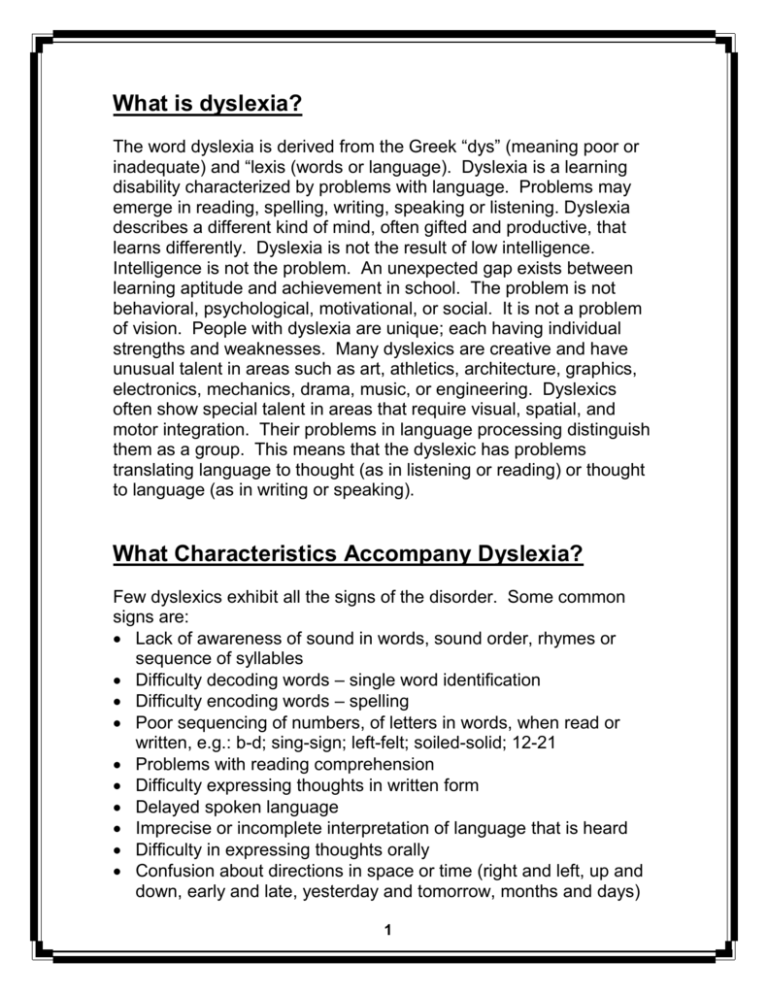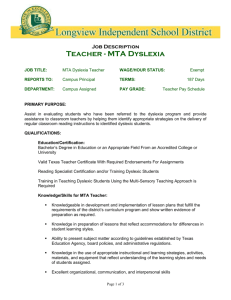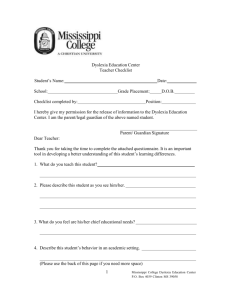What is dyslexia
advertisement

What is dyslexia? The word dyslexia is derived from the Greek “dys” (meaning poor or inadequate) and “lexis (words or language). Dyslexia is a learning disability characterized by problems with language. Problems may emerge in reading, spelling, writing, speaking or listening. Dyslexia describes a different kind of mind, often gifted and productive, that learns differently. Dyslexia is not the result of low intelligence. Intelligence is not the problem. An unexpected gap exists between learning aptitude and achievement in school. The problem is not behavioral, psychological, motivational, or social. It is not a problem of vision. People with dyslexia are unique; each having individual strengths and weaknesses. Many dyslexics are creative and have unusual talent in areas such as art, athletics, architecture, graphics, electronics, mechanics, drama, music, or engineering. Dyslexics often show special talent in areas that require visual, spatial, and motor integration. Their problems in language processing distinguish them as a group. This means that the dyslexic has problems translating language to thought (as in listening or reading) or thought to language (as in writing or speaking). What Characteristics Accompany Dyslexia? Few dyslexics exhibit all the signs of the disorder. Some common signs are: Lack of awareness of sound in words, sound order, rhymes or sequence of syllables Difficulty decoding words – single word identification Difficulty encoding words – spelling Poor sequencing of numbers, of letters in words, when read or written, e.g.: b-d; sing-sign; left-felt; soiled-solid; 12-21 Problems with reading comprehension Difficulty expressing thoughts in written form Delayed spoken language Imprecise or incomplete interpretation of language that is heard Difficulty in expressing thoughts orally Confusion about directions in space or time (right and left, up and down, early and late, yesterday and tomorrow, months and days) 1 Confusion about right or left handedness Similar problems among relatives Difficulty with handwriting Difficulty in mathematics – often related to sequencing of steps or directionality or the language of mathematics Who Has Dyslexia? According to researchers, learning disabilities, such as dyslexia, affect as many as one in seven people in this country. Dyslexia occurs among all groups, regardless of age, race, or income. Many successful people are dyslexic, and many dyslexic people are successful. Recent research has established that dyslexia can run in families. A parent, brother, sister, aunt, or grandparent may have had similar learning difficulties. What Can Be Done? Individuals with dyslexia require a structured language program. Direct instruction in the code of written language (the letter-sound system) is critical. This code must be taught bit by bit, in a sequential, cumulative way. There must be systematic teaching of the rules governing written language. This approach is called structured, or systematic language instruction. Individuals with dyslexia require multisenory delivery of language content. Instruction that is multisensory employs all pathways of learning – at the same time, seeing, hearing, touching, writing, and speaking. Such a delivery requires a teacher or therapist who is specifically trained in a program which research has documented to be effective for dyslexic individuals. The program we use in the Lewisville Independent School District is Multisensory Teaching Approach or MTA. The MTA program is a comprehensive curriculum that places primary emphasis on the 85 % of the English language that is phonetically reliable for reading and spelling. There are four major areas of study: alphabet and dictionary skills, reading, spelling and cursive handwriting. Our teachers are required to take eight days of initial training in the MTA curriculum with ongoing training each month during the school year. 2 Resources Your child’s Dyslexia Interventionist is:________________________________. The school phone number is:______________________________. Her/His conference period is:______________________________ Lakshmi Valdes is the Dyslexia Interventionist Supervisor. Her phone number is 469-713-5200. In LISD we are very fortunate to have a parent organization, PODS, Parents of Dyslexic Students. Contact your child’s Dyslexia Interventionist for more information regarding meetings. The web site of the International Dyslexia Association is: www.interdys.org. This web site contains valuable information and current research about dyslexia as well as an e-mail exchange. There are several sources for obtaining books on tape to use with your child. Texas Talking Book – Texas State Library (1-800-2529605)or www.texastalkingbooks.org - Provides free tape recorder and library material, but no textbooks are available. Recording for the Blind and Dyslexic – Princeton, N. J. (1-800-221-4792) or www.rfbd.org - Provides textbooks as well as reading material. There is an initial fee as well as an annual fee. The Internet is also a valuable resource in locating taped reading materials. www.amazon.com is one site that offers a large variety of books. You will find attached a copy of a portion of the Texas Education State Law for Dyslexia and an overview of laws concerning dyslexia. If you would like to see the complete law it can be accessed at the TEA website. Also, you will find a copy of a historical perspective of dyslexia, a summary of laws concerning dyslexia, and a suggested reading list for parents. 3 Suggested Reading for Parents and Students Can’t Read, Can’t Write, Can’t Talk Too Good Either *Charlie’s Challenge Root and Gladden *Thank You, Mr. Falker Polacco Learning to Read: The Great Debate Dyslexia Defined Jeanne Chall Critchley, Macdonald and Eileen Understand Dyslexia Anne Marshall Huston *Dyslexia – Unraveling the Myth The Many Faces of Dyslexia Priscilla Vail Margaret Rawson *Smart Kids with School Problems Priscilla Vail *When You Worry About the Child You Love *Dyslexia in Adults Clark Ed Hallowell Nosek *How to Develop Your Child’s Gifts and Talents in Reading *Keeping a Head in School Dr. Mel Levine The Orton Emeritus Series International Dyslexia Association Cheney Overcoming Dyslexia Sally Shaywitz Smart But Feeling Dumb Harold N. Levinson Parenting a Struggling Reader Straight Talk About Reading Susan L. Hall and Louisa C. Moats Susan L. Hall and Louisa C. Moats Helping Children Overcome Learning Difficulties Jerome Rosner * Books available for check-out from Dyslexia Office at the Administration Bldg. 4 Historical Perspective Until the late 1800’s, beginning reading instruction emphasized teaching letter/sound relationships; reading and spelling were taught as related skills. Cursive handwriting was taught to all students. Around the early 1900’s the emphasis gradually shifted from directly teaching sound/symbol relationships to a whole word approach. A manuscript form of writing began to be used as the introductory form of handwriting in the early 1940’s; cursive handwriting instruction was then deferred for approximately two years. Late 1920’s: Dr. Samuel T. Orton saw patients unable to read, spell, or write, but could determine no physical cause. Recognizing that the treatment was educational, he prescribed specialized multisensory teaching techniques, and in the 30’s, worked closely with a number of educators, including Anna Gillingham. 1930’s: Anna Gillingham had already been using multisensory techniques before she worked with Dr. Orton. She and Bessie Stillman co-authored a teacher manual first published in the early 40’s. Miss Gillingham believed that both students and teachers must be taught one-to-one. 1965-75: Under the direction of Aylett R. Cox and Dr. Lucius Waites, the staff of the dyslexia child study unit at Texas Scottish Rite Hospital in Dallas, Texas, extended and refined the Orton-Gillingham methodology into a program known as Alphabetic Phonics. They taught students in small, homogeneous groups of 6-8 students, and also trained teachers in groups. 1978: Margaret T. Smith began writing curriculum materials to make it easier to teach Alphabetic Phonics. The materials, called Multisensory Teaching Approach (MTA), were field-tested in a public school setting for nine years. A four year study growing out of the field testing project showed that after receiving MTA instruction, both regular and remedial students in third through sixth grade showed improvement in reading and spelling, some at highly significant levels. 1987: MTA was published by Educators Publishing Service. The comprehensive program includes specific directions for instruction, practice materials, and criterionreferenced post-tests. 1991: MTA: Teaching a Process for Comprehension and Composition was published by Margaret T. Smith and Edith A. Hogan. The practical guide incorporates multisensory, guided discovery techniques for teaching whole language ideas. The book includes information for the teacher, minilessons, and duplicating masters for practice activities. 1994: Multisensory Teaching System (MTS) Reading Program was published by Margaret T. Smith. MTS follows the same curriculum as MTA, and is written in teacherfriendly minilessons making it easier to teach. MTS has been taught in K-2 grades in addition to other reading programs, in chapter remedial reading for students with less serious reading problems and in adult literacy classes. COPYRIGHT 1994 BY MARGARET T. SMITH. PERMISSION TO DUPLICATE GRANTED. 5 TABLE OF CONTENTS What is Dyslexia? Page 1 Characteristics of Dyslexia Page 1-2 Who has Dyslexia? Page 2 What Can Be Done? Page 2 Resources Page 3 Suggested Reading List Page 4 Historical Perspective Page 5 Laws Concerning Dyslexia Page 6 TEA Dyslexia Law Page 7-29 Lewisville ISD Dyslexia Parent Booklet







